How to get rid of opossums? (Humanely)
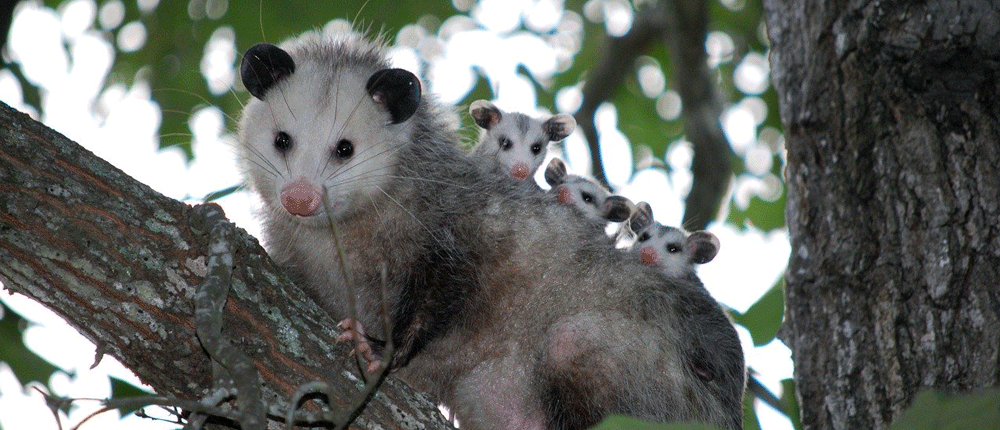 Survey Your Property
Survey Your Property
The first step in getting rid of opossums is confirming that you actually have an infestation. Because of their nocturnal habits, you’ll usually hear them before you see them. They’ll hiss and screech throughout the night and you’ll find trash strewn everywhere in the morning. Other common signs of opossum damage are foul odors near your rummaged trash cans, tracks with opposable thumbs, and scratch marks outside your home. Keep an eye out for droppings as well!
Opossums like to build their homes out of pre-made ones abandoned by others. This means that your basement, porches, and crawlspaces are perfect hiding places. Make sure you’ve sealed off any entry points like small holes and cracks and put a screen on your vents and chimneys.
Locate Activity
Once you’ve confirmed it’s an opossum infestation, it’s time to look for the nest. Shine a light down covered spaces like a pile of wood or leaves, shrubberies, hollow logs, and holes and crevices in your property. Make sure to look in your crawlspaces and up your attic as well.
Remove Attractants
Getting rid of opossums would be pointless if you haven’t removed everything that attracts them to your property. Make sure you’ve done everything so that you won’t have to deal with getting rid of them again.
- Seal your garbage bins and repair any holes or cracks. You can add additional plastic bags inside so that the smell isn’t as strong and it wouldn’t attract wildlife.
- Don’t leave any pet food outdoors as it is easy food for other animals as well.
- Keep your property clean and tidy to prevent any opossums from hiding in unkempt
shrubberies or left out garden equipment.
Get Rid of Opossums
Once you’ve removed any possible things that might attract them back to your property, it’s time to get rid of these little creatures as humanely as possible.
1. Baiting and Trapping the Opossum
- best bait for opossums is fish or apples. You can use any type of scraps or food but the general rule for professionals is “the smellier the better”. We advise against pet food since you might trap your local stray cat instead. It’s best to smear your bait in and on the trap so that they can smell it better. You can place a toy inside the trap as well, the opossum will play with it out of boredom and it’ll be easier for you to take it away in the morning. You can even create a small trail that leads to the trap for a better chance of opossums finding the bait.
- There are different kinds of traps. Whatever type you opt for, make sure that it is big enough for opossums to fit in, and that you’re catching them as humanely as possible. Your trap should be about 30 to 40 inches long and 12 inches high. This size requirement allows opossums to freely enter the trap unrestrained.
- Be sure to check out your state’s laws and restrictions regarding game and trapping before doing anything on your own.
2. Using Dogs
- If you have a dog, then you’re one step closer to getting rid of opossums. A dog, preferably a hunting breed, keeps wildlife away since most are scared of being prey. Opossums will keep out of your way once they smell your dog’s scent as they tend to shy away from confrontations and animals they think are predators.
- You can also use pet fur instead of purposely taking your pet outdoors. Just sprinkle your pet’s fur after brushing them in areas with opossum activity. Opossums tend to avoid competition, so they’ll stay away. It’s also a safer option since aggressive and starving opossums might hurt your pet in search of food.

3. Fencing
- Installing a mesh fence along your property line can keep opossums and other wildlife away. Be sure to bury your fence and stake at least 6 inches under to prevent them from digging under it. This method is actually one of the most successful ways to keep out unwanted animals from your property. It also saves you money as you won’t have to invest in further pest control.
4. Lights On
- Motion-activated lights aren’t just for your security; it can be used against wildlife as well. The fact that opossums are nocturnal animals can be used to your advantage in this case, as bright lights will easily scare them away. Our tip is to point your lights on areas where there is the most activity, like garbage cans, sheds, and dark areas where they can possibly hide. Motion-activated lights are better since you don’t need steady lights in these areas, and it will save you money on your electricity bill.
5. Sonic Repellents
- Another motion-activated tool is a sonic repellent, which emits a high-frequency sound or vibration that animals can’t stand. These sounds can’t beheard by our ears, but animals typically can’t stand them, causing them to run as far away as possible from your house. You can set them up in your perimeter wall or fence or near your house, but we strongly advise against this method if you or your nearby neighbors have pets that they keep outdoors. You might end up scaring your own pets away while they’re out playing.
6. Odor Repellents
- This consists of liquid or granular repellents that typically have a predator’s urine as an active ingredient. This makes opossums think that there’s a predator nearby, or they have crossed their territory, causing them to scurry away in fear. Keep in mind that this is a short term solution, since animals tend to get used to scents, and they’ll ignore it if they’re hungry enough. Make sure you place your odor repellent a good distance away from any doors or windows to avoid the scent wafting inside your house.
7. DIY Treatments
- Ammonia.
Cut a hole on top of a can or jar lid. Pour a small amount of
ammonia inside. Place a rag and let it soak a bit before pulling one end of the rag up the hole you’ve created until it completely blocks the hole. The rag will soak up the ammonia and create a kind of scent stick that disperses ammonia in the air. Make sure you wear gloves during the process. Avoid this treatment if you have pets. - Spices.
Mix water, dish soap, and hot sauce or crushed hot pepper in a 2:1:1 ration. Pour them in a spray bottle and spray it on areas with opossum activity. These animals hate the smell and taste of pepper, and they will actively avoid
these areas.
 How to trap a opossum?
How to trap a opossum?
Contrary to popular belief, opossums aren’t actually dirty nor dangerous. In fact, they’re beneficial to most gardens and lawns. They are unsung heroes in slowing the spread of Lyme disease, keeping your property clear of unwanted pests that eat your plants, and they’re often rabies-free and scared of people as well! Opossums will always try to stay out of your way and you’ll almost always never see them.
Although opossums aren’t as dangerous as the other wildlife, they’re still a nuisance to most homeowners. As nocturnal animals, they raise a ruckus in the middle of the night, preventing a good night’s sleep, and then make you clean up their mess in the morning. If you have unwanted opossums, the best way to deal with them humanely is to trap and remove them from your property. You can read down below on how to trap opossums effectively. Keep in mind that trapping opossums is subject to your state laws, so be sure to check that out first!
Selecting a Trap
Selecting a trap isn’t easy, they come in a variety of sizes and styles that can make or break whether you’ll catch an opossum or not. Your trap should be about 30 to 40 inches (0.76 – 1.02 meters) long and 12 inches (0.3 meters) high. This size requirement allows opossums to freely enter the trap unrestrained.
There are different kinds of traps. There are traps with one door and others with two. The most usual mechanism is a spring-loaded one where a platform holds a bait, and when the weight is lifted the door snaps shut, trapping the animal inside. Another type is a hook type where the bait is hanging instead of resting on a weight-sensitive platform. Leg-hold traps work by literally holding on to the animal’s leg until you decide what to do with them. Whatever type you opt for, make sure that it is big enough for opossums to fit in, and that you’re catching them as humanely as possible.
Bait
The best bait for opossums is fish or apples. You can use any type of scraps of food but the general rule for professionals is “the smellier the better”. You can also use dog or cat food, but we advise not doing it as you might trap your local stray cat instead. It’s best to smear your bait in and on the trap and set it on the trigger in a way that it can’t mess with the spring-load mechanism. You can create a small trail that leads to the trap for a better chance of opossums finding the bait.
Time and Location
The best location you can place your trap in is where you notice the most activity. Place it in the middle of the room if the opossum is living somewhere indoors. If it’s a crawlspace, then place it about 2 feet (0.61 meters) away from the entrance. Make sure that your trap is on a level surface and out of direct sunlight to avoid a very hot trap that can harm the animal. It’s best to set your trap before nightfall as opossums are nocturnal animals.
Check Frequently
You should check your trap every morning to see if it has trapped an opossum. Make sure to release them as soon as possible to avoid caging them longer than necessary. Trapping opossums is a short-term solution. Make sure that after getting rid of unwanted opossums, research and check how you can deter them from getting back into your yard.
How to keep opossums from getting into your house?
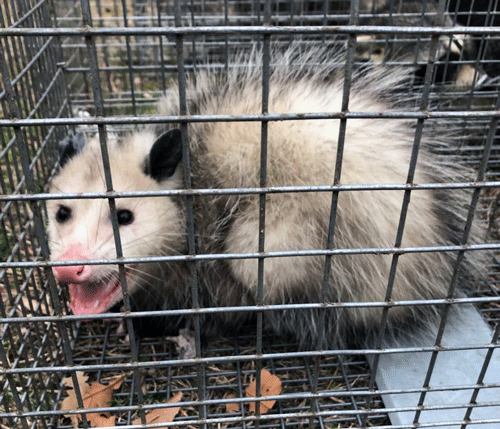
Opossums are excellent scavengers who keep neighborhoods clean by being carrion eaters and controlling rodent and insect population. In fact, neighborhoods with opossums tend to be cleaner than the ones without them. However, we can all agree that they make bad pets, and they can and will wreak havoc in your home, so it’s best to prevent them from getting into your property. Easy to say, but how exactly can you prevent opossums from getting into your home? Read down below!
Get Rid of Food
Animals are attracted to food and leaving any in your yard is an easy meal for wildlife, especially opossums. Don’t leave pet food outdoors, and always keep your garden clean by picking up fallen fruits and vegetables and properly discarding them.
Keep Your Trash Lids Closed
Always cover your trash cans and lock them if possible. Opossums love trash because it’s everywhere and it’s easy food for them. Don’t let your trash pile up and always seal them in plastic bags.
Remove Hiding Spots
Opossums typically use shelters that are already made instead of creating their own. This means that brush piles and stacks of leaves or wood are easy hiding spots. Thin out your hedges and shrubbery to deter them from making it their new home. Store unused garden equipment so that they won’t be used as shelters. Always remember to keep things clean and tidy in your property as opossums hate a tidy environment where they can’t hide. Protect the underneath of your deck or porch by blocking off any openings using mesh wiring or some sort of metal barrier. Make sure you bury it at least an inch to prevent them from digging under it.
Secure Open/Accessible Areas
Double-check your pet doors at night to avoid opossums using them to enter your home. Cover your vents with metal vent covers and make sure your cover allows steam, smoke, and air to pass but not anything else. Chimneys should be fitted with a chimney cap and/or a grid screen.
Secure your garage door and seal any type of food (pet food, bird seeds, etc.) in airtight containers so that they can’t smell them. Asses your property and immediately repair any damage you can find. Remember, opossums can dig underneath, but they’re also expert climbers so you’ll have to look up and down while scanning the area.
Create a Fence
This method is the most successful one in keeping opossums and other wildlife out of your yard. Use a metal mesh and bend the top away from your property. Attach this to 4-foot-tall columns and bury them at least 6 inches (ca. 15 cm) deep. Don’t attach the bent top to the column so that it’s unstable and loose. This bent top prevents opossums and other wildlife from scaling the fence as the top will just sag under their weight, preventing them from reaching the top.
How to get opossums out of my attic?
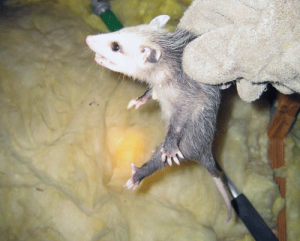 So, you have an opossum in your attic? Well, you needn’t worry. You’re not alone. Opossums are a nuisance in most urban centers, neighborhoods, and some countryside homes. But since they’re not aggressive to humans, you can quickly deal with them.
So, you have an opossum in your attic? Well, you needn’t worry. You’re not alone. Opossums are a nuisance in most urban centers, neighborhoods, and some countryside homes. But since they’re not aggressive to humans, you can quickly deal with them.
Ready to get started? Below are the steps.
1. Inspect your property for signs of an opossum infestation
Before you start planning on how to deal with possums, you’d probably want to know the real enemies to fight. How would you know that it’s an opossum, bat, or even your cat? Look for the signs below.
- Look for tracks having opposable thumbs
- Scratching on the walls of your house
- Cat-size droppings
- Foul smell
Note: Ensure to put on protective gear before starting.
2. Check for opossum nests
Opossums carry nesting materials into their new den. You can also hear their noise from the attic combined with scratching sounds. If you want to confirm the presence of an opossum in your attic, the following steps are handy.
- Put on protective clothing and head to the attic.
- Using a flashlight, look for an opossum’s nest. You might find it in one of the dim-lit corners.
- Check for the presence of foul-smelling cat-sized droppings. With any or all of the above present, you’re sure to have an opossum in your attic. Now, let’s deal with them in the next step.
3. Deal with the opossum
Once you’re sure that you have an opossum in your attic, there are many ways of getting rid of it. Below are some of the methods you can use.
- Starving the opossum
This is one of the humane ways of getting these dirty scavengers out of your attic. You can do that by emptying the trash cans or keeping the cans locked. Also, ensure that you keep your pet’s food inside your house before night falls. And if you have fallen fruits in the garden, be sure to pick them all. By doing so, the opossum will have no option but to move to a new area with plenty of food. - Trapping
This is the most popular way of dealing with an opossum. If you opt for this method, you will have to buy a live cage-like trap. The trap presents a humane way of dealing with the opossum. - Ensure your cage trap is at least 10 x 12 x 32 inches.
- Get bait that specifically attracts opossums to avoid trapping stray cats and other none targeted animals. To achieve the best results, use jam, peanut butter spread on a slice of bread, whole chicken eggs, overripe bananas, or grapes.
- Place the traps at the opossum’s routes and tracks.
- Relocate the trapped opossum. If your local laws prohibit relocating animals without a license, contact professional wildlife removers in your area to help you deal with the problem.
- Starving the opossum
So, you have an opossum in your attic? Well, you needn’t worry. You’re not alone. Opossums are a nuisance in most urban centers, neighborhoods, and some countryside homes. But since they’re not aggressive to humans, you can quickly deal with them. Ready to get started? Below are the steps.
1. Inspect your property for signs of an opossum infestation
Before you start planning on how to deal with possums, you’d probably want to know the real enemies to fight. How would you know that it’s an opossum, bat, or even your cat? Look for the signs below.
- Look for tracks having opposable thumbs
- Scratching on the walls of your house
- Cat-size droppings
- Foul smell
Note: Ensure to put on protective gear before starting.
2. Check for opossum nests
Opossums carry nesting materials into their new den. You can also hear their noise from the attic combined with scratching sounds. If you want to confirm the presence of an opossum in your attic, the following steps are handy.
- Put on protective clothing and head to the attic.
- Using a flashlight, look for an opossum’s nest. You might find it in one of the dim-lit corners.
- Check for the presence of foul-smelling cat-sized droppings.
With any or all of the above present, you’re sure to have an opossum in your attic. Now, let’s deal with them in the next step.
3. Deal with the opossum
Once you’re sure that you have an opossum in your attic, there are many ways of getting rid of it. Below are some of the methods you can use.
- Starving the opossum
This is one of the humane ways of getting these dirty scavengers out of your attic. You can do that by emptying the trash cans or keeping the cans locked. Also, ensure that you keep your pet’s food inside your house before night falls. And if you have fallen fruits in the garden, be sure to pick them all. By doing so, the opossum will have no option but to move to a new area with plenty of food. - Trapping
This is the most popular way of dealing with an opossum. If you opt for this method, you will have to buy a live cage-like trap. The trap presents a humane way of dealing with the opossum. o Ensure your cage trap is at least 10 x 12 x 32 inches.
- Starving the opossum
- Get bait that specifically attracts opossums to avoid trapping stray cats and other none targeted animals. To achieve the best results, use jam, peanut butter spread on a slice of bread, whole chicken eggs, overripe bananas, or grapes.
- Place the traps at the opossum’s routes and tracks.
- Relocate the trapped opossum. If your local laws prohibit relocating animals without a license, contact professional wildlife removers in your area to help you deal with the problem.
Preventive Measures
- Empty your trash bins and fence off your garden.
- Inspect and seal off all the potential entry points on your home’s sidings and roof.
- Fence off your home.
- Scare tactics.
Note: trapping wildlife presents a problem when it comes to the relocation of the animal. Therefore, check with your local laws if they permit wildlife relocation without a license, or else you might find yourself with hefty fines.
- Empty your trash bins and fence off your garden.
- Inspect and seal off all the potential entry points on your home’s sidings and roof.
- Fence off your home.
- Scare tactics.
Note: trapping wildlife presents a problem when it comes to the relocation of the animal.
Therefore, check with your local laws if they permit wildlife relocation without a license, or else
you might find yourself with hefty fines.
How to keep opossums out of my garbage/trash?

Like any other wild animal, opossums like nesting near a food source. That’s why proper garbage management is essential. Since opossums are omnivores, the combs through the garbage to get food.
Fortunately, there are several ways for keeping these scavengers away.
- Keep your garbage indoors until the day for garbage collection.
Keeping your garbage indoor will deny the opossum access to it, thereby starving it. As a result, the opossum will relocate to another place if your home doesn’t have other reliable sources of food. - Use a wildlife-proof container or anchor the bin securely (for outdoor garbage).
Opossums can thrive well just by feeding from your garbage bin. That’s why keeping your garbage secure pays off in the fight against opossums and other scavengers.- Purchase a wildlife-proof garbage container.
Purchase a metallic can with a secure lid that locks conveniently to deny the opossum access to the garbage. - Anchor the garbage container to a tree or a pole.
This keeps the garbage can secure and prevents being toppled over by a committed opossum. If you cannot get a pole and there are no trees near the place for garbage, put a heavy object on top of a closed garbage can. The item should outweigh any opossum or raccoon efforts to get it down and scatter the trash. - Use a bungee cord to secure the lid of the container.
This technique keeps away most of the food-seeking wildlife such as raccoons, squirrels, dogs and cats.
- Purchase a wildlife-proof garbage container.
- Spray your garbage cans with a strong-smelling substance.
Smelly substances deter a hungry animal from seeking food from your garbage. Such chemicals include Windex, diluted bleach, or Ammonia. - Pack your garbage in a double bag.
Double plastic bags, especially the strong-smelling ones, can help to contain the food smell that is likely to attract wild animals from your neighborhood. - Eliminate other food sources.
Hungry opossums eat anything edible, ranging from kitchen remnants, pet’s food, and fallen fruits in your garden. Therefore, ensure you clean up your yard and eliminate all fallen fruits (if any). Additionally, keep your pet’s and birds’ food indoors before nightfall. - Install an outdoor motion detector flashlight.
Shining light on opossums at night is nearly impractical. But with this kind of flashlight, opossums and other wildlife, such as raccoons, will stay away. The light flashes anytime a motion is detected. - Trapping
If all the ways discussed above fail, then the next step would be trapping the animal and relocating it away from your property. The effective distance is estimated to be 10 miles. When using this method, consider the following.- Choose the most appropriate trap (live cage trap) to avoid injuries or killing the animal captured.
- Choose the appropriate bait. Ensure to use a bait with a higher probability of attracting an opossum more than just any other nocturnal animal. Whole eggs and jam can be an option.
- Place the cage trap strategically in the route frequently followed by the opossum.
- Check your trap at close intervals, release non-targeted animals, and reset the trap.
o Relocate the trapped opossum at least 10 miles away.
- Repair your existing fences or erect a new one to keep the possum out of your compound.
Note: If you’ve used some of the above methods, but you still have an opossum problem, consider contacting opossum removal experts in your area for assistance
How to keep opossums from eating pet food or bird seeds?
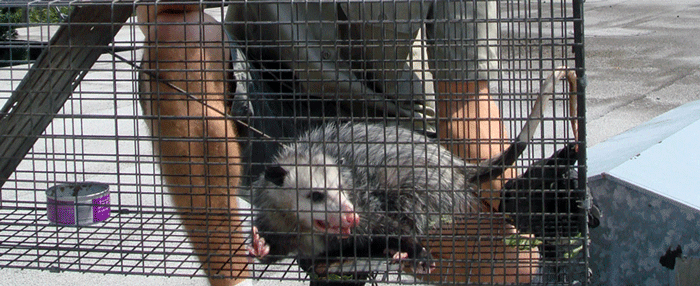 So, you have a problem with opossums eating the food meant for the birds or pets? Well, we must have had you in mind. The opossum is one of the dirty scavengers that finds pleasure in eating easily available pet food. However, it’s strong memory for recalling the location of food is shocking. As a result, it will frequently eat your pet’s food after the first successful attempt.
Fortunately, you can prevent them from eating your pet’s food and bird feed in the following ways.
So, you have a problem with opossums eating the food meant for the birds or pets? Well, we must have had you in mind. The opossum is one of the dirty scavengers that finds pleasure in eating easily available pet food. However, it’s strong memory for recalling the location of food is shocking. As a result, it will frequently eat your pet’s food after the first successful attempt.
Fortunately, you can prevent them from eating your pet’s food and bird feed in the following ways.
- Suspend your bird feeders on a wire tied between two baffled poles or two trees. This prevents the opossum from gaining access to your bird’s food. Even though opossums are great climbers, navigating on a wire to get to the bird feeder is impractical.
- To exclude small animals such as an opossum, you can make your baffle through the following steps.
- Get 4-8 one-liter bottles of empty soda.
- Slide about 2-4 of the bottles onto the wire evenly on both sides of your feeder.
- Alternatively, you can slide two or more 2-foot sections of a plastic pipe over the wire, preferably with a 2-inch diameter.
- Ensure to use spill-proof feeders. Make sure your choice of bird feeder is one that ensures little or no feed spillage. In case of spillage, you should remove the spilled feed. Since opossums are good at remembering the places they have previously found food, the first mistake could be not cleaning up spilled food. After the first trip, they’ll continue coming to your home to try their luck.
- Clear the ground of spilled feed. Spilled feed can be attractants not only to opossums but also to other hungry wild animals. Home-loving wild animals such as raccoons also cherish grains. Therefore, dropped feed also puts your home at risk of a raccoon invasion. You can imagine the horror of dealing with rodents, raccoons, and an opossum invasion at the same time. It could be costly and unbearable!
- Remove all your pet or bird food. Removing your pet food temporarily is one of the ways of keeping an opossum away. When you realize that your pet’s food has become the main target of a wild animal, relocate it for a while.
- Feed your pets or birds throughout the day. Giving your small amounts of food throughout the day can help to minimize spillage and feed remaining in the feeder to attract wild animals.
- Avoid feeding your birds when they can fend for themselves. Do not feed birds from April to November. During this time, birds have plenty of natural food to depend on.
- Keep your garbage covered.
- Keep your pet’s food in your house at night.
- Pick up all the fallen fruits.
- Build fences that make it hard for them to navigate through.
- Use repellants to keep the opossum away from your home. Spraying an onion solution around the perimeter of your home can work pretty well.
How to keep opossums out of my yard or garden?
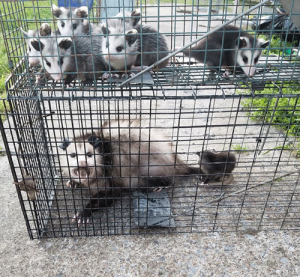
Opossums are considered a garden pest by many. But, are these nocturnal animals really problematic and do they threaten the growth of your vegetables and fruits?
Do Opossums Destroy the Garden?
The truth is, opossums don’t really destroy a garden. They aren’t perfect, meaning they will take a few snacks here and there. However, opossums prefer rotting food and generally stay away from fresh vegetables. However, they will invade compost piles, pet dishes, and uncovered trash cans and leave a mess.
Should I Get Rid of Opossums?
Opossums are usually beneficial garden residents. They eat ticks, slugs, rodents, snakes, dead animals, and other garden pests. An opossum may actually improve the garden situation by eliminating other pests. If you have a slug problem, you’ll be thankful to have an opossum around. Or, maybe the opossum is why you don’t have a slug issue?
How to Keep Opossums Out of the Garden
If you find the opossums are taking more than the occasional snack, or leaving too much of a mess, there are ways to get rid of them. Do not use poison. Poisons hurt more species than the one you are killing. Also, children and household pets may eat it by accident.
Opossums nest under decks, patios, and houses. Blocking off access to these areas prevents them from taking up residence. Do this at night, after the opossum has left the nest or you will trap them inside.
The only sure way to keep an opossum out of the garden is to build a fence. It will need to be at least 4-feet high, with 2 feet underground, and a curved top to prevent climbing. To discourage opossums from taking up residence, cover compost piles, don’t leave pet food sitting out, tightly cover trash cans, keep the garden well-lit (opossums don’t like
light), and pick up trash, especially rotting fruit and vegetables.
How to protect my pets from opossums?
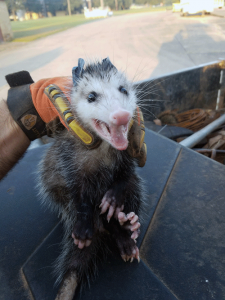
Opossums are our wild neighbors and even though they are quite gentle animals, very often they are seen as pests rather than friends. We accuse them of making noises in the middle of the night, knocking over our garbage or attacking our pets and farm animals. But do those quiet marsupials actually pose a threat to our closest furry friends?
ARE OPOSSUMS DANGEROUS?
Opossums are in fact a very docile species and rarely pose any kind of threat. We often blame them for destroying our gardens or killing our chickens, however, most of the time they are absolutely innocent of those crimes. Even though opossums feed on harmful insects, not many of us like having them around our house and maybe that’s why we decide to blame everything on them. It even seems that we like to complain about opossums being there rather than them causing any actual problems – although the rambling the opossums can cause at night may be slightly annoying.
WILL OPOSSUMS ATTACK YOUR DOG OR CAT?
This scenario is highly unlikely. Opossums don’t tend to attack domestic animals, however, they can when provoked or while protecting their young. There is a bigger possibility of a dog harming and injuring an opossum than this happening the other way around. Opossums prefer to avoid confrontation, their hissing is purely defensive and if that doesn’t work, they use their special tactic of ‘playing dead’ in hopes that the attacker will simply leave them alone. Naturally, a threatened opossum may bite in self-defense or show its teeth to scare the other animal but most likely it won’t attack first.
HOW TO PROTECT MY PETS?
The best way of protecting your pets is taking action in getting control of your surroundings so that the opossums are not tempted to visit your garden. First of all, make sure you are not leaving pet food or trash outdoors during the night – opossums are nocturnal animals. If you have fruit trees in your garden, remember to not leave rotten fruit on the ground and pick your garden crops when they are ripe. You should also be careful with pet doors in your home and try to secure them during the night, so that the wild animals are not tempted to get indoors in search of food. It is also good to know that opossums use abandoned animal burrows instead of digging their own, so if you see a deserted den you might want to bury it. Opossums often hide in brush piles and holes under concrete slabs, so it is essential to eliminate them if you want to make your property opossum-free. You should also remember that opossums don’t stay in one place for too long, so if you notice them in your garden, big chance is they will be moving away in no time.
How to make my property less attractive to opossums?
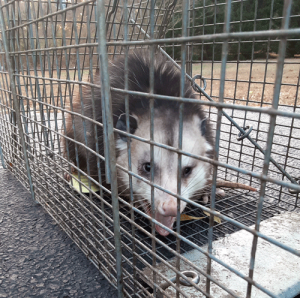 Opossums can be seen as cute wild animals, however, we are still not very fond of their company. They can be a bit of a troublemaker and even though they move from place to place often, you may want to consider making your home less accessible to them so that they won’t make a stop at your property. If you don’t want opossums to go through your garbage or eat your pets’ food, then here are a few steps to make your property less attractive to them.
Opossums can be seen as cute wild animals, however, we are still not very fond of their company. They can be a bit of a troublemaker and even though they move from place to place often, you may want to consider making your home less accessible to them so that they won’t make a stop at your property. If you don’t want opossums to go through your garbage or eat your pets’ food, then here are a few steps to make your property less attractive to them.
1. REMOVE THEIR FOOD SOURCE
Opossums are quite lazy animals and therefore they absolutely love trash. Not getting rid of your garbage regularly can definitely be a reason why opossums decide to visit your property. Our recommendation is to clean your trash bins as frequently as possible and make sure the whole area near your garbage is kept tidy, so there are no bits of junk lying around on the ground. Make sure the plastic bags with your leftovers are sealed, your trash doesn’t pile up and the garbage is hard to get to.
2. ELIMINATE ENTRY POINTS
These marsupials wander into your property in search of food and if they find it, they will want to stay around for a bit. However, as we mentioned before, they are quite lazy wildlife and don’t create their own nests. One of the ways of preventing opossums from staying in your garden is to eliminate the places they potentially may use for hiding. Inspect your home for cracks and holes, and if you find one, make sure to seal it properly so that opossums cannot get inside. It is also recommended to secure pet doors at night, as it has been observed that opossums try to get indoors that way as well.
3. TRIM BRANCHES AND BUSHES
Opossums are in fact very good climbers, which is not good information for those of you who have trees and bushes around your household. It is crucial to trim the branches if they touch your roof, otherwise, opossums may get into your house through vents or chimneys.
4. REPAIR DAMAGE
Any damage around your building or in a fence is a blessing for opossums. Those wild animals tend to access your property by digging under your fence or squeezing through small holes. If you notice any gaps, make sure to patch them as you find them. Installing screens over your vents is also proven to be helpful.
5. KEEP TIDINESS
It is quite a general point, but nevertheless extremely important. Clearing your garden and keeping your property area clean of trash is the best way of not inviting opossums. Messy gardens with fallen fruits and debris are a perfect spot for them to shelter and eat, so make sure you don’t leave piles of leaves, wood or any leftover food.
We hope that those 5 simple steps will help you in making your property less attractive to opossums!

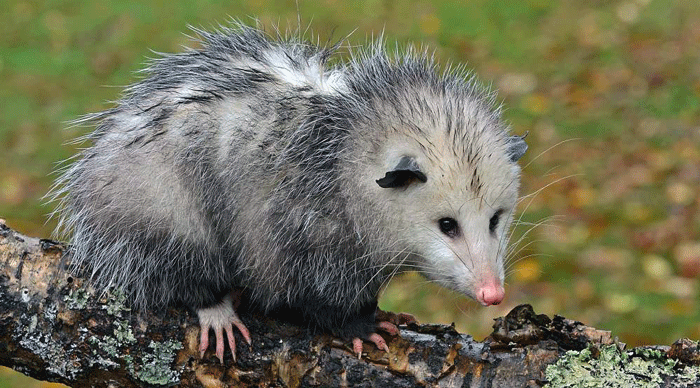
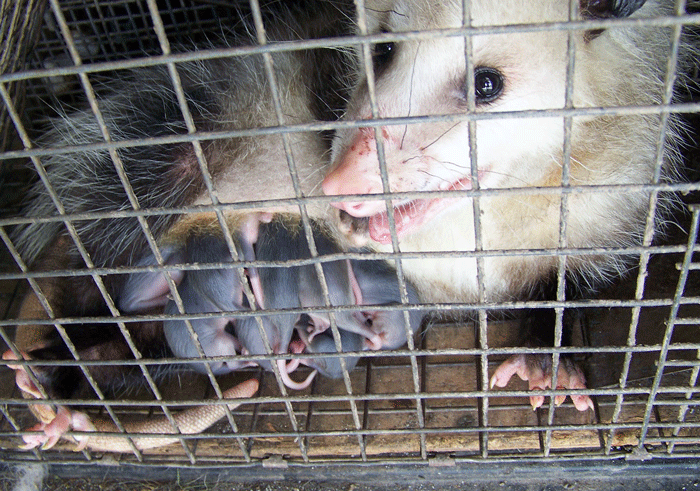 How to trap a opossum?
How to trap a opossum?